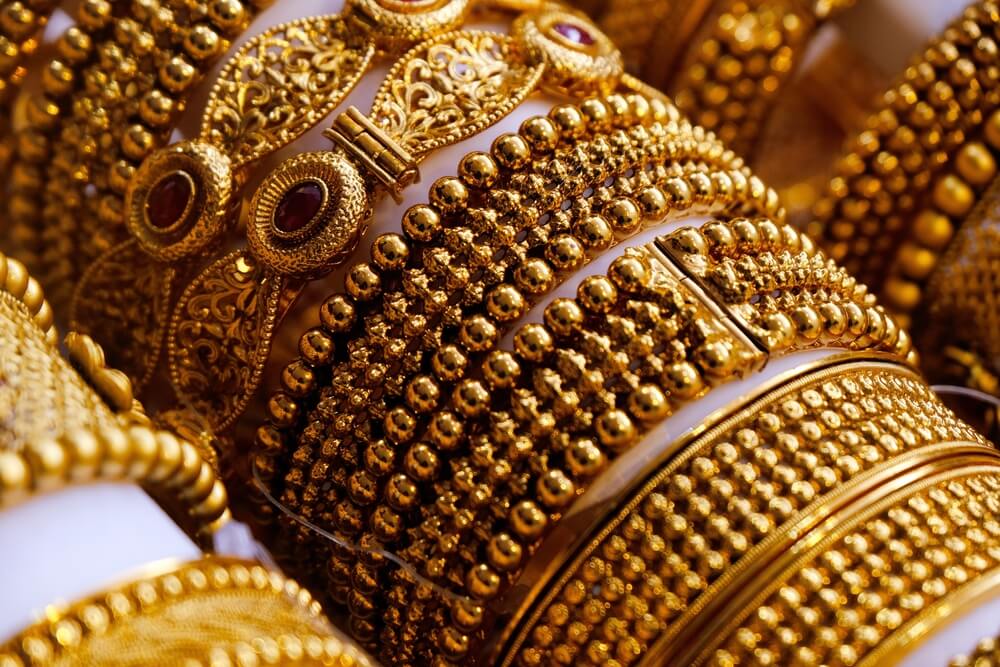
All the Types of Gold You Must Know
Gold is a coveted precious metal. It’s loved, appreciated, and sought after by retail and industrial buyers alike. Due to this constant demand for the material and the fact that it’s a rare commodity, it’s pretty naturally not accessible to all. Most individual buyers have to save for several months or years to own a piece of gold.
Those who buy gold do it for investment reasons or to use it as an adornment piece. The gold investors seek 24k or pure gold. Buyers who aren’t particular about the gold being in its purest form exist in millions. The various types of gold that we shall discuss in-depth later in the article are available on the market primarily to cater to such buyers.

So, what are those different types of gold? How are they distinct from each other? Let’s find that out and more in this article where we talk about:
- The different varieties of gold (colors, karats)
- Items that aren’t necessarily gold but look the part
- The affordable gold making process and more
The goal here is to introduce you to the various types of gold and familiarize you with pseudo gold articles and their making processes so that you know what you’re looking for. Keep reading.
Table of Contents
The Different Types of Gold
Originally, all gold is the same. Gold assumes various shapes, traits, colors, etc., based on its blend and how it’s shaped.
Pure Gold
Also called 24K gold, pure gold is essentially gold in its original form. Solid gold has no impurity of any kind. However, the gold is quite malleable and can bend easily with little force and scratch when prickled.
Colored Gold
When mixed with other metals, gold assumes different hues: pink, white, etc. Other metals such as silver, copper, platinum, zinc, etc., are added to gold to lend it some much-needed rigidity. White gold and rose gold are two common color variations achieved with gold.
Yellow Gold
Pure gold is yellow gold. But yellow gold could also be 18 karats. An 18k yellow gold usually consists of 75% gold, 12.5% silver, and 12.5% copper. For a darker yellow hue, makers reduce the silver content to 10% and up the copper constituency to 15%. The variations are galore.
Rose Gold
Rose gold is gold mixed with copper. Formerly called Russian gold due to its popularity in Russia, rose gold is commonly used to make bracelets, wedding rings, and other kinds of jewelry. Rose gold is also called pink gold or red gold, but the three are not the same.
Red gold has more copper content than rose or pink gold. Of the three similarly colored varieties, pink gold has the least copper. Rose gold uses a bit more than pink gold, but not red gold. Rose and pink gold also have some silver thrown into their mix.
White Gold
White gold is yellow gold alloyed with silver, nickel, palladium, or manganese. White gold’s pale silvery appearance makes the precious metal look less like gold and more like sterling silver or platinum. At times, rhodium plating could be used to boost the piece’s appearance.
White gold’s applications vary based on the alloy metal used. White gold with nickel as the other metal, for instance, is solid, and, therefore, the ideal material for pins and rings. On the other hand, the palladium alloy variant is soft and pliable and employed accordingly.
Other colors gold could assume are green, purple, blue, etc.
- Green gold has 14-18 karat gold blended with either just silver or silver with zinc or cadmium, as the other metal. The constituents of a dark green gold alloy can be broken down as gold (75%), silver (15%), copper (6%), and cadmium (4%).
- Purple gold, also called violet gold, is around 80% pure gold, with the remaining 20% comprising gold-aluminum intermetallic. Due to its “intermetallic” nature, purple gold is not malleable, but it easily shatters. It’s, therefore, used more like a gem in existing pieces of jewelry than a piece of jewelry by itself.
- Blue gold is a gold-gallium/indium alloy. Gold-indium has 46% gold (11 karats) and 54% indium. With gallium, the blend ratio could be different.
- Grey gold is a gold-palladium alloy. Jewelers could replace palladium with silver, copper, and manganese.
- Brown gold or black gold exist too. There’s, however, no blending involved. Instead, copper-rich gold alloys are treated with potassium sulfide to achieve the hue.
To learn more about the proportions of the various metals added to colored gold or karats in general, click on “Gold Purity: A Complete Guide”, where we’ve deep-dived into the topic.
Layered Gold
Colored gold is made by integrating other metals with pure gold. Those gold varieties tend to have a higher gold content. On the other hand, layered gold is essentially quasi gold that has a much lesser amount of gold than the other metals it incorporates.
Rolled Gold
Rolled gold is thin gold alloy sheets pressed onto brass, an alloy of zinc and copper that resembles gold. The rolling is done with heat so that the malleable gold alloy adheres to the brass firmly. The gold used could be 10k, 14k, or even 18k gold.
Gold-Filled
Gold-filled is a kind of rolled gold, but it has more gold content than the rolled variant, usually two to three times more. The yellow gold alloy used constitutes at least 5% of the item’s total weight. Because gold-filled jewelry employs more gold, it’s a lot more resistant to wear and tear.
Not to mention, the high gold content could make it difficult to discern real gold from a gold-filled item, as the base metal (brass) also looks like gold and adds to the homogeneity of the piece.
Gold Plating
Gold plating is a thin sheet of gold applied atop brass, copper, silver. Compared to gold-filled and rolled gold, gold plating uses much lesser gold. For context, a gold-plated item has around 1/10th of a gold-filled article’s gold alloy, which means gold plating wears off quickly with time. Rolled gold and gold-filled are comparatively a lot more resilient.
Unlike gold-filled or vermeil, gold plating doesn’t require the gold layer to have a certain thickness or karat weight. However, the gold alloy layer must be at least 8 to 10 karats so that it’s technically “gold”. Due to the minimal amount of gold used, gold-plating jewelry costs much less than a gold-filled ring or a gold-rolled watch.
Vermeil Gold
Also called silver gilt, vermeil gold is essentially silver (pure or sterling) layered with gold. The term “vermeil” denotes the vermeil jewelry-making process. Vermeil gold employs electroplating to bind the silver and gold. Also, the base metal must be silver. It cannot be copper or zinc. Moreover, the gold layer must be 10 karats or more and 2.5 microns thick. Due to the increased thickness of vermeil, the gold cover lasts a long time — at times, even a lifetime. It will not tarnish, fade, or wear off the way gold-plated jewelry could. It’s, therefore, safe to assume vermeil gold is the highest quality of layered gold and a solid affordable alternative to pure gold jewelry.
Read more: Physical Gold vs. Paper Gold
Gold Fusing and Gold Electroplating: A Brief Overview

As you might have already learned, the above-mentioned layered gold varieties are either mechanically bonded pieces or gold electroplated. But how do those two methods work?
Gold Fusing
Gold fusing is attaching a layer of gold alloy to a base metal using heat and pressure. The base metal is usually brass or sterling silver. With fusing, it’s easier to achieve a thicker gold layer than with electroplating. And due to the thicker layer, the layered gold is a lot more resistant to wear and tear. Rolled gold and gold-filled items usually have fused gold.
Gold Electroplating
Gold electroplating is a gold-layering method that employs electrical currents to bond the base metal with gold. Electroplating is a three-step process: electro cleaning, activator, and plating.
The first step is cleansing the base metal (copper, brass, etc.) by dipping it into an alkaline-based solution. Electro cleaning eliminates any residual dirt or contamination that could hinder seamless electroplating. The base metal remains in the solution for 20 to 30 seconds.
Next, the cleansed metal is dipped in pure water for a quick rinse, after which it goes into the activator. The activator renders the metal’s surface “chemically cooperative” to easily adhere to gold.
After about 30 seconds, the metal is removed from the activator and rinsed off in clean water. The metal is bathed again in distilled water so that there are no remnants of the rinsing water or other chemical solutions on it.
In the third and final step, the metal piece is dipped into a 100°C (212°F) hot solution with a 2.7 voltage electric current passing through it. The plating solution comprises a brass electrode, a gold electrode, and a gold-based compound solution — for instance, a gold sulfate solution.
Within three minutes of immersion, the metal assumes a plating thickness of 0.5 microns. For a thicker cover, the plated metal is taken out of the solution, turned, and doused again for another few minutes. Once the required thickness of gold plating is achieved, the freshly plated piece is immersed into a gold solution rinse formula. The rinsed sample is then dried with a soft cloth so that no water droplets are clinging onto it. Once completely dry, the gold-plated piece is ready for use.
Read more: Is Gold Mineral or Metal?
Conclusion
Gold’s yellow hue is distinct and attracts people to the metal. But not everyone likes the color — with some finding it a bit too flashy. The lower karat variants or different gold colors exist to serve people who are not fans of 24K gold. And for those who don’t have issues with the quintessential gold color but cannot afford the precious metal, there’s gold-layered jewelry.
Kindly note, there is no white or pink layered gold jewelry. If you fancy the different gold colors but cannot afford them, you will have to wait until you can afford them or someone devises a method to make plated pieces in colored gold.
FAQs
Is there a difference in appearance across different layered gold variants?
Fresh out of their processes, all layered gold look the part or like pure gold. The differences start to show only after a period of use, with gold-plated jewelry likely to lose its sheen the quickest. The most resilient of them all, as mentioned earlier, is the vermeil variety.
Can layered gold be treated as investment pieces?
All layered gold articles, including vermeil gold, are designed to be affordable alternatives to pure gold. They cannot be treated as investment pieces because they contain too little gold. Even gold layer jewelry that’s gold plated with 24K gold is not “gold” in the truest sense of the word.
Are white gold and rose gold jewelry considered “real gold jewelry”?
White gold jewelry and pink gold or rose gold jewelry go down as actual gold items because their gold content is usually more significant than the other metals added. If there’s less gold than copper, silver, nickel, or any other added metal in particular gold pieces, those will not qualify as gold jewelry. Any gold alloy jewelry with less than 10K gold is not authentic gold jewelry — at least, not in the States.


